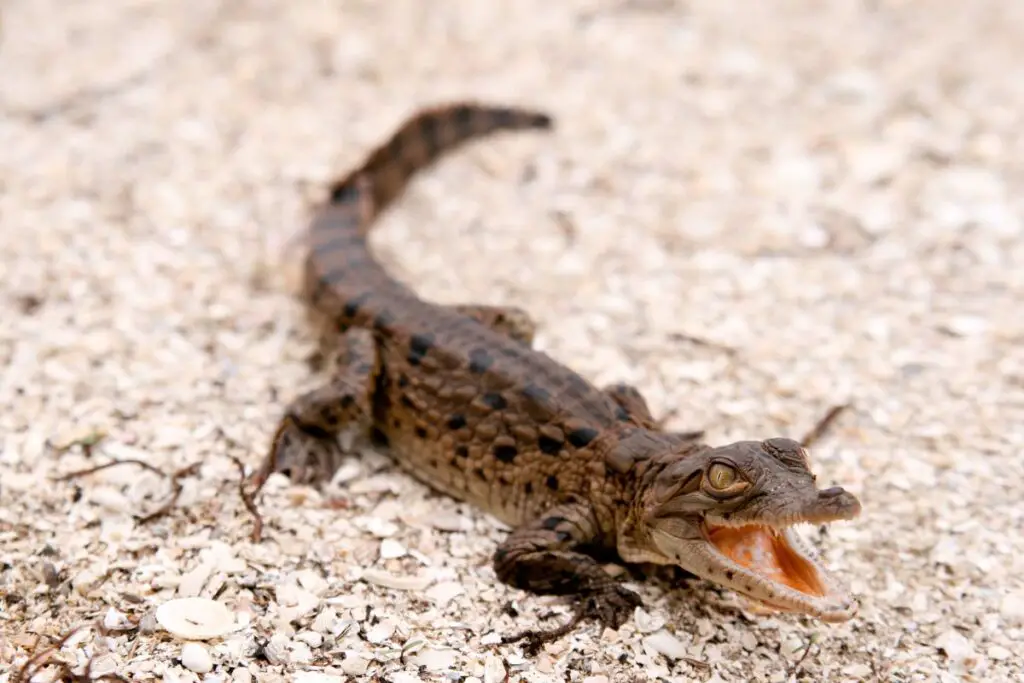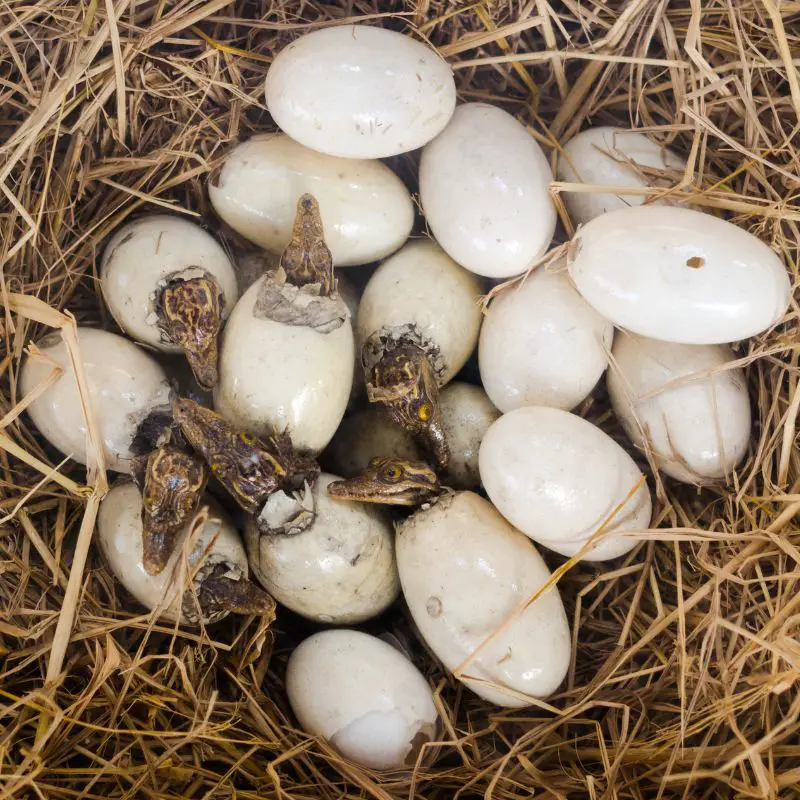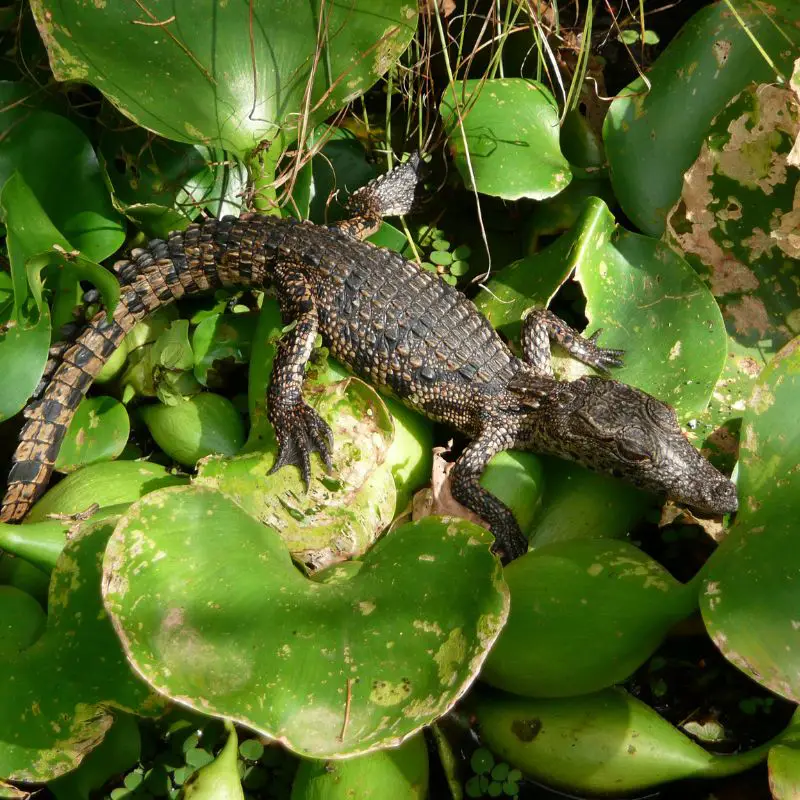Baby crocodiles are among some of the most adorable little animals on earth. Their formidable size and scaly skin hide their true child-like nature. But don’t let that rough exterior fool you – these pint-sized crocs have many interesting facts sure to make your heart swoon.
Baby crocodiles are called hatchlings and are 8 to 12 inches long. Usually, they’re born with 60 teeth. The crocodile hatchlings are very dependent on their mothers. Surprisingly, baby crocodiles have a very high mortality rate, so only a few survive. That’s why a crocodile litter can have as many as 60 eggs.
In this article, we’re going to look at baby crocodiles and cover everything you need to know.

- 10 Facts About Baby Crocodiles
- 1. Baby Crocodiles Are Known as Hatchlings
- 2. Crocodile Babies Depend a Lot on Their Mothers
- 3. Crocodiles Lay Up to 60 Eggs at a Time
- 4. Baby Crocodiles Mortality Rate Is Very High
- 5. Hatchlings Have Many Teeth
- 6. Temperature Affects the Hatchling’s Gender
- 7. Baby Crocodiles Stay in Large Groups
- 8. Hatchling Shed Their Teeth
- 9. Some Crocodile Hatchlings Can Climb
- 10. Baby Crocodiles Shouldn’t Be Domesticated
- Final Thoughts On Baby Crocodiles
- FAQs
10 Facts About Baby Crocodiles
Here are some amazing facts you don’t want to miss.
1. Baby Crocodiles Are Known as Hatchlings
Crocodile babies are called hatchlings. They get this name from the minute they break out of the egg.
The mother crocodile is called the cow, with the male being the bull. After reaching sexual maturity, they become adults.
A group of little hatchlings is called a “creche” of crocodiles or a “pod.”
2. Crocodile Babies Depend a Lot on Their Mothers
Baby crocodiles depend on their mothers from birth. Since crocodile nests are buried under the ground for protection, the babies rely on their mothers to dig them out as they hatch.
Baby crocodiles will make grunting sounds to call out to their mothers for help.
When raising the young, mother crocodiles have an active role. The bond between the mother and the crocodile baby is unique. That’s just adorable!
3. Crocodiles Lay Up to 60 Eggs at a Time
Another exciting thing about crocodiles is that they can lay as many as 60 eggs simultaneously. Mother crocodiles will lay their eggs on sandy beaches and bury them for protection. The eggs are the same size as goose eggs.
Scientists believe that crocodiles lay so many eggs because of the high infant mortality rate of the species. Predators like lizards, raccoons, and mongooses hunt for crocodile eggs, threatening unborn babies.
The success of the crocodile nest depends on how well it is protected from predators. For example, if a raccoon invades a crocodile nest, the number of eggs hatching will drastically reduce.
4. Baby Crocodiles Mortality Rate Is Very High
Crocodiles are mighty reptiles, so it surprises many that their babies have a high mortality rate. Most baby crocodiles won’t even live up to their first birthdays.
Since they’re strong reptiles, predators don’t cause adults much harm. Yet, the babies are very vulnerable.
These babies depend significantly on their parents at the egg and hatching stages. While humans threaten adult crocodiles, babies are at risk from other predators like raccoons, hyenas, lizards, mongooses, turtles, and big cats.
These predators hunt down crocodile eggs before they can hatch.
5. Hatchlings Have Many Teeth
Baby crocodiles are born with as many as 60 teeth. However, this depends on the species. Crocodiles are polyphyodont, so their teeth constantly develop and are replaced with new ones.
One of these is the egg tooth caruncle, which is very important. It helps the hatchling breach the egg’s shell to come out. Soon after hatching, crocodile hatchlings will lose this tooth. This tooth is present on the crocodile’s nose.
Throughout their life, crocodiles have a set of 60 sharp teeth that constantly replace over time. Baby crocodiles also develop their teeth and lose them regularly.

6. Temperature Affects the Hatchling’s Gender
One thing that amazes most people about crocodiles is that their baby’s gender is determined by the temperature it receives in the first part of the incubation period.
The babies will be males if the nest temperature is between 89.6 to 91.4 degrees Fahrenheit or 32 to 33 degrees Celsius.
If this temperature is cooler or warmer, female crocodile babies will be produced. Usually, the temperature at the nest’s top and bottom differ, resulting in both genders.
7. Baby Crocodiles Stay in Large Groups
Unlike other reptiles, crocodile babies prefer to stay in large gatherings. They sunbathe together and hang out as well.
Baby crocodiles remain with the rest of the group. The burdens of hunting and protecting the young are shared in a large group.
Living in groups improves the chances of survival of the babies.
8. Hatchling Shed Their Teeth
The number of teeth crocodile babies have will depend on the species. Yet, most species will keep developing new teeth by shedding the previous set.
Baby crocodiles need sharp teeth and jaws to bite down their prey. However, they cannot clean their teeth, can they?
So, crocodile babies shed their teeth and regrow new ones at fast intervals based on use. However, shedding slows as more energy is expended on this process as they grow older.
9. Some Crocodile Hatchlings Can Climb
If you look at the appendage and shapes of crocodiles, it’s easy to assume that they aren’t the best climbers. Yet, that is only sometimes true. Baby crocodiles can very well learn to climb because of their lightweight and small size.
Juveniles are faster and better at climbing than adults. Baby and juvenile crocodiles can climb 30 feet or 360 inches above the ground. So, if a crocodile chases you, don’t try to climb a tree!

10. Baby Crocodiles Shouldn’t Be Domesticated
Crocodiles are fascinating animals, and people have thought of keeping them as pets. However, to keep them, you need to apply for a permit.
Keeping crocodiles, even babies, as pets aren’t recommended because these animals are dangerous and belong to the wild.
Even baby crocodiles are wild creatures and have the potential to attack. So, they are near impossible to tame and keep as pets.
Final Thoughts On Baby Crocodiles
Crocodiles are, without a doubt, vicious and powerful reptiles, but their babies are adorable.
While they develop their predatory instincts as they grow older, you cannot help but fall for their cuteness when they’re little.
FAQs
What Do Baby Crocodiles Feed On?
Baby crocodiles feed on small prey like water insects, frogs, tadpoles, small fish, snails, and crustaceans. They also eat birds and insects. As they grow older, they start to eat larger prey.
How Large Are Baby Crocodiles?
Baby crocodiles are around 8 to 12 inches (0.667 to 1 foot) in length when born. As newborns, crocodiles weigh approximately 70 g (0.154 lbs).
Can Baby Crocodiles Hurt Humans?
Crocodiles, babies, or adults can bite humans quite severely. A hatchling’s bite won’t be as painful, but it can still be pretty nasty.
